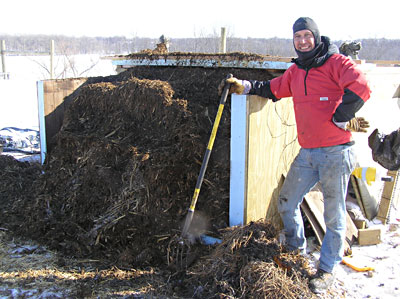 |
|
| Rich Schuler, energy consultant with Practical Farmers of Iowa, by the insulated compost bin. Heat from composting warms water which is stored in tanks and available to heat greenhouse soil when needed. | |
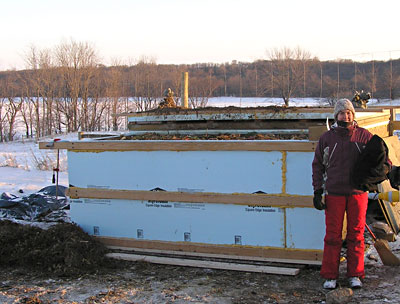 |
|
| Sally Gran runs TableTop Farm, where the innovative heating system was trialed. | |
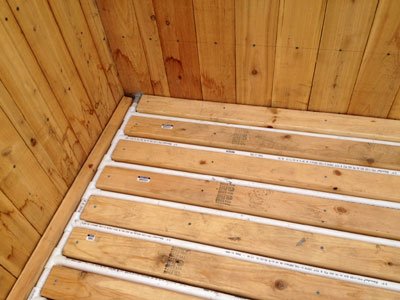 |
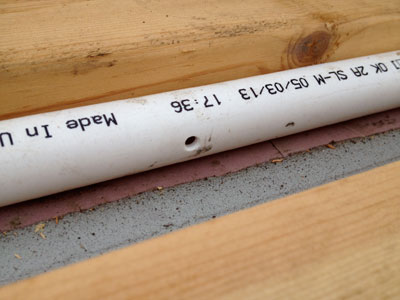 |
| The compost is aerated by blowing air through PVC pipes set on the floor of the compost chamber. | Air exits the PVC pipes through holes. |
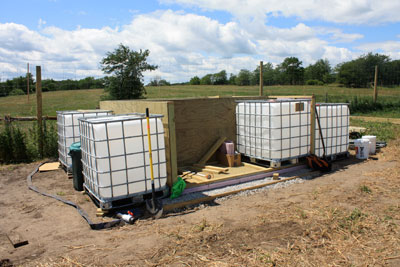 |
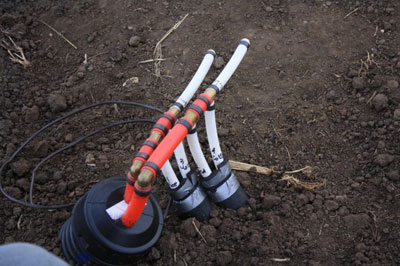 |
| Heated water is stored in 275-gallon totes until it is needed to warm greenhouse soil. | PEX tubing connects to the hot water coming from the compost system. |
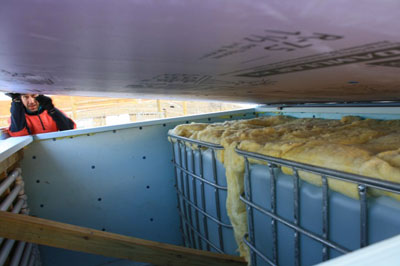 |
|
| Schuler lifts the lid to show two of the water tanks that are heated by the compost. | |
– and To Make Quality Compost
By Liz Kolbe and Rich Schuler
What if farmers using high tunnels had a system that generated compost and provided supplemental heat to protect early- and late-season crops from unpredictable temperatures? An innovative on-farm project by Practical Farmers of Iowa is doing just that: using waste heat from composting to protect delicate crops inside high tunnels during spring and fall cold spikes.
The prototype system started heating some high tunnel soil shortly after a crop was planted in early April at TableTop Farm near Nevada, Iowa. It increased soil temperatures by 5 degrees during a mid-April cold snap – equal to more than 5 gallons of liquid propane for the 300-square-foot test plot. Sally Gran, who runs TableTop Farm, says the boost was a nice surprise – especially compared with her previous heating costs.
“Last year we installed a $1,400 propane heater in the high tunnel and spent an additional $1,200 on LP,” Sally says. “The cost was unsustainable for the farm budget and didn’t really fit with our energy use philosophy. This time of year, we’re hovering around freezing, and 5 degrees can be the difference between a plant living and dying.”
How the System Works
Rich Schuler, energy consultant with Practical Farmers, explains that heat extracted from the 5-cubic-meter aerobic composting chamber is transferred over time to water in four 275-gallon insulated tanks. To do this, the system uses two heat exchangers: 1) a coiled stainless steel tube nested in the compost, through which water runs; and 2) a set of copper tubes in the “exhaust system” through which water is pumped. A blower forces air into the bottom of the compost chamber, and as the air passes through the compost, it picks up heat and humidity. The warm moist air that exits the aerobic chamber passes through the second heat exchanger, and the heat is transferred to the water in the copper tubes.
The “design temperature range” for the compost chamber is 131-150 F. The low end (i.e., 131 F) meets the organic certification requirement, and above 150 F, the substrate begins to go anaerobic locally, and fungi start to die.
When heat is needed in the high tunnel during a cold snap, a pump moves hot water from the tanks into PEX tubing under the greenhouse soil, about 20 feet away. The pump is turned off at the end of the cold period, and heat generated from composting again warms the water in the tank over time. The four totes are estimated to have the heating capacity of 6 gallons of LP.
Most materials for the system are common hardware store items: plywood, foam board insulation and PVC pipes. Other components include pumps, a blower, stainless steel tubing and four used, food-grade plastic totes.
Schuler says the system was used on four separate cold snaps between April 13 and May 17. During that time it delivered heat to the soil for a total of 12 days, moving a total of 910,000 BTUs of heat into the soil “test area.” This is equivalent to 11.7 gallons of LP (with a burner/boiler efficiency of 85 percent).
Eco-friendly Energy
“The system was designed to use very little electricity,” Schuler says, adding that it’s been operating off-grid on a single 140-watt solar PV panel. “An important goal of the project is to put alternative hardware in the field that is not nearly the cost of other renewable technologies.
“Materials for the prototype system cost roughly $7,000, including the solar PV components. The next goal will be to build a system with 80 percent of the performance of the prototype, at 20 percent of the cost. I’ll need several more ‘compost runs’ to optimize the system before I release construction details.”
The project, adds Schuler, produces quality compost directly on the farm with less labor, machinery and fuel than most methods. It eliminates the need to turn compost by forcing air through the insulated compost box with a solar-powered blower.
“After the warmest phase of the composting process, the material in the compost chamber is moved outside to finish curing before field application,” Schuler says. “The system is then loaded with fresh material, and the process starts over again.”
Practical Farmers’ Energy Program is designed to help farmers reduce off-farm inputs and carbon footprints. The compost heat project is funded by The Ceres Foundation, Soper Farms and the members of Practical Farmers of Iowa.
For more information, see www.practicalfarmers.org or contact Liz Kolbe, Practical Farmers of Iowa, 515-232-5661, [email protected], or Rich Schuler, energy consultant, 515-441-3257, [email protected]. More details of the building process appear at https://practicalfarmers.org/blog/2013/11/05/compost-heat-going-underground/.
